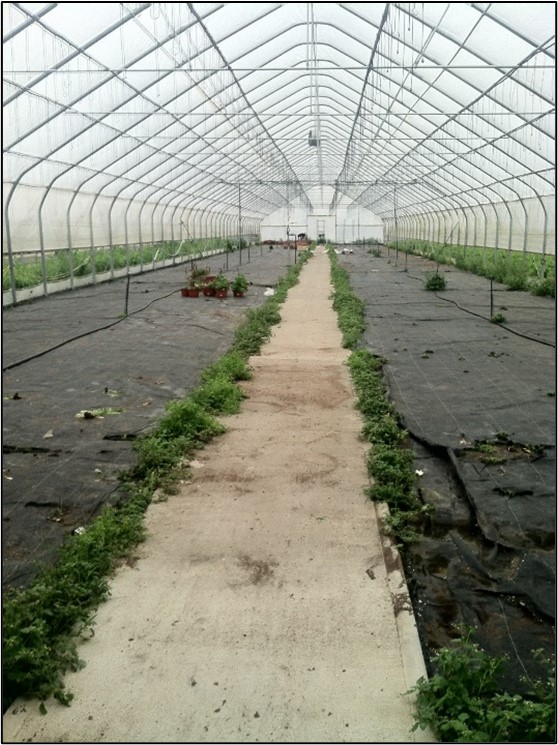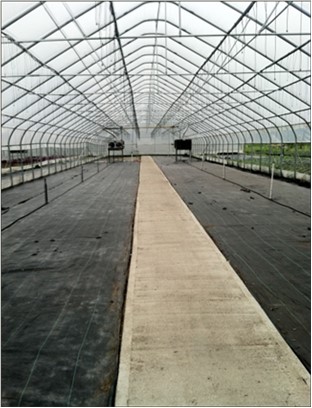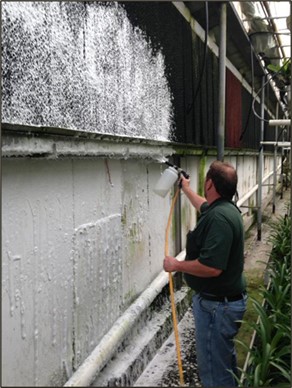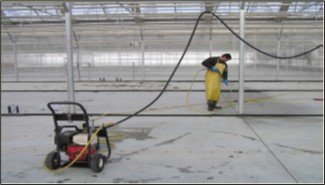With the onset of another growing season, much effort is placed on preparation and planning. During this time, we often search for novel approaches to enhance our operations. Whether it be new equipment, inputs, or practices, there is always something we can try that could benefit production and increase profitability. In many cases, the fundamentals get obscured by the next “silver bullet” or line of new genetics. Regardless of your standard operation protocols, we believe that sanitation is a key factor in having a successful season. The environment of our growing space steers the crops we grow. Whatever is done on the front end will manifest when the time comes for your crop to hit the racks. Very few management practices have the duality of being preventative, curative, and cost-effective whereas a strong pre-season sanitation plan does. For this reason, we strongly focus on starting with a clean production space. In this article, we will outline the framework of a comprehensive sanitation program.
Physical Cleaning
There are three prongs to a successful sanitation program: physical cleaning of the production area, chemical cleaning, and sanitizing. The first and most arduous work is the physical cleaning of the production area. In this step, we work through the debris and chaos from the prior season or crop cycle. It should be a “clean sweep” where growers power wash and remove all debris and leftover material from the production area. It’s worth noting that this part is essential for the remaining sanitation steps to be successful.

Figure 1: Untreated

Figure 2: Treated with Marengo
Weed Control
Once the house has been physically cleaned, we recommend utilizing an herbicide to control weed species in the greenhouse. Apart from being a nuisance, weeds can harbor insects and diseases pests that can carry over to the next season. There are very few options labeled for usage within greenhouses. Post-emergent herbicides are used to control established weeds, while pre-emergent herbicides are applied before weed establishment and prevent the development of newly emerging weeds. Below is a list of herbicide options labeled for greenhouse usage:
| Product | Item Number | Comments |
|---|---|---|
| Marengo | 72-2809* | Pre-Emergent: Labeled for shade, hoop, and gutter-connected houses for use on floors or weed mats under benches with no plant contact. |
| Marengo G | 72-28181 | Pre-Emergent: Labeled for hoop houses, gutter-connected greenhouses, and shade houses on floors or weed mats under benches with no plant contact. |
| SureGuard SC | 72-8218* | Pre-Emergent: No plants present. Can be used in empty greenhouses with specific instructions per label. |
| Axxe | 72-1050 | Post-Emergent |
| Cheetah Pro | 72-1595* | Post-Emergent: No plants present. |
| Envoy Plus | 72-14451 | Post-Emergent: Selective, grassy weeds only. |
| FireWorxx | 72-1608 | Post-Emergent |
| Reward | 72-2866* | Post-Emergent: Can be used in greenhouses when no desirable vegetation is present. |
| Scythe | 75-10512 | Post-Emergent |
| Finale XL T&O | 72-1605 | Post-Emergent: No edible plants present. |
| Roundup Pro Concentrate | 72-2869 | Post-Emergent: No plants present. |
Chemical Cleaning
Once the greenhouse has been physically cleaned, and the weeds have been treated, the next step is to apply a cleaning agent such as Strip-It Pro or Horti-Klor (see the table that follows for additional options). This can be done effectively using a hydraulic sprayer or a foaming wand. Cleaners are strong acids or bases with detergents that work on all biological materials. Contact and coverage are key with these products. Thoroughly apply these to benches, concrete floors, cooling pads, ground cover fabrics, and other non-porous surfaces in the production area. For cleaners, allow a 3–5-minute wet treatment time and follow up with a clean water wash down. Avoid allowing cleaner to dry prior to rinsing. If a cleaner is allowed to dry, it leaves a film that traps dirt. If this occurs, re-treatment with the cleaner is required to remove the film. Although not discussed in detail, sanitation of irrigation lines and plastic containers uses the same sequential steps of cleaning and then sanitizing. If you would like more information specific to irrigation sanitation, please reach out to GGSPro.
Note: Avoid crop contact with chemical cleaners, as these products will cause crop damage & are not approved for crop application. Always ensure that staff utilizes proper PPE, the required PPE for the products can be found within the label.
| Product | Item Number | Comments |
|---|---|---|
| Strip-It Pro | 74-2125* | Cleaner: No plant contact. Targets debris, biofilm, and algae on hard surfaces and plastics. |
| Horti-Klor | 74-2105 | Cleaner: No plant contact. Targets debris, biofilm, and algae on hard surfaces, plastics, and tools. |
| GreenClean Acid Cleaner | 74-2040 | Cleaner: No plant contact. Targets debris, biofilm, and algae on hard surfaces, plastics, and tools. |
| GreenClean Alkaline Cleaner | 74-2045 | Cleaner: No plant contact. Targets debris, biofilm, and algae on hard surfaces, plastics, and tools. |
| GreenCleanPro | 74-20521 | Cleaner: No plant contact. Targets debris, biofilm, and algae on hard surfaces. |

Sanitizing
After the chemical cleaner has been rinsed, we follow up with the final step of applying a sanitizing agent. ZeroTol 2.0, SaniDate 5.0, SaniDate 12.0, and KleenGrow can be used on all surfaces associated with ornamentals and edibles produced in greenhouses. These products are applied and left to air-dry on the treated surfaces leaving behind no chemical residues. For best results, spray or foam onto surfaces and do not rinse.
| Product | Item Number | Comments |
|---|---|---|
| ZeroTol 2.0 | 71-35501* | Sanitizers: All surfaces including areas of crop contact. Targets algae, bacteria, and fungi on hard surfaces, plastics, and tools. |
| KleenGrow | 74-21101* | |
| SaniDate 5.0 | 71-35001* | |
| SaniDate 12.0 | 71-35351 |

In closing, implementing a few cleaning and sanitation steps into a grower’s production protocol will greatly reduce the risk of pest and disease carry-over between crops. Choose the right product for the space, clean up physically and chemically, and then sanitize.
Note: not all products are registered in all states. Some pesticides are restricted use in some states or regions and not others. It is the responsibility of the applicator to read and follow all label directions, remembering that labels may change. Other products may be safe and effective. Rates, application methods, and edible status are detailed in our GGSPro Insecticide & Fungicide Guides. Griffin also offers the 5th Edition GGSPro Technical Reference Guide in both English and now Spanish versions. This valuable resource outlines a wide range of pest control options and information on pollinator safety, BCA’s, scouting, weed management, plant lighting, nutrition, water quality, and more!
